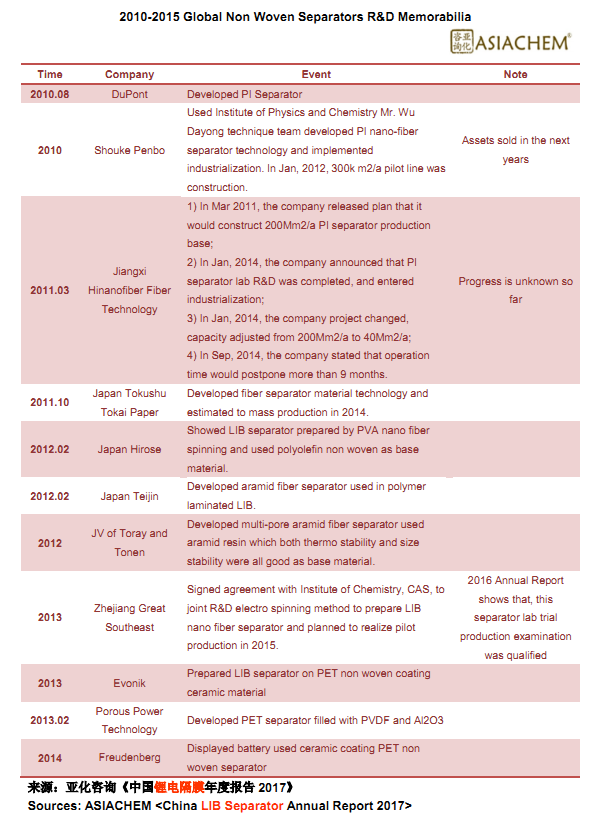LIB separator base material mainly includes polyolefin material and non woven material. Polyolefin material has characteristics of excellent mechanical property, chemical stability and relatively inexpensive, which makes it widely used in LIB R&D since preliminary stage and becomes mainstream direction of LIB separator. However, recently, national policies come up with higher requirement to power battery monomer and system energy density, which come up with challenges to performance of polyolefin separators.
Non woven separators have merits of thermo stability and high porosity. What is more, its 3D pore structure can effectively avoid short link phenomenon caused by needling and increase liquid retention rate. Above characteristics of non woven separators especially suit for applying to power LIB. However, ASIACHEM ‘China LIB Separator Annual Report 2017’ shows that, large application of non woven separators progress is slow in recent years.
Non woven separator base materials normally select PET, fibrin, PI, PA, aramid fiber (PPTA) and polyurethane fiber etc. Since 2010, the US DuPont announced that it used electro spinning technique and prepared PI separators, many domestic and abroad enterprises actively R&D non woven material separators. ASIACHEM ‘China LIB Separator Annual Report 2017’ shows that, from 2010 to 2016, some enterprises’ R&D achievements are shown as the table below.

Enterprises and institutions below do relative R&D and industrialization layout in recent 2 years.
Dreamweaver
In 2016, Dreamweaver launched many kinds of non woven separators, included Silver, Gold and Titanium 3 series. Silver Series is the thinnest, with about 20μm thickness. Aim of the company is to reduce the thickness to 15μm in 2017 and 12μm in 2018. The company stated that, the separator can provide excellent safety protection and extended using life of batteries to each application which has energy storage requirement, including solar cell, EV and e-tool etc. power batteries and those digital LIB products which safety requirement is higher. The company stated that, it has produced 100Mm2/a this kind of separator in Glatfelter production line in Germany.
Mitsubishi Paper Mills
In Jul, 2017, Mitsubishi Paper Mills announced that, the company coated ceramic ions to non woven separators which constructed by polyester fiber, strengthens high temperature resistance of battery separators. It can endure as high as 470℃ temperature. Information shows that, in 2018, the company estimates to invest about JPY 3bn device in Takasago Factory and annual capacity will increase to 33Mm2/a.
China Haisum Engineering
China Haisum Engineering stated in 2016 Annual Report that, mainly R&D project of the company R&D Center is industrialization R&D of NEV LIB separator base material.
In the report period, the company R&D aim was to solve technique bottleneck of ceramic non woven separator coating volume and internal resistance were big; test technology performance indexes on LMO battery production line; complete ceramic non woven LIB separator technology; meanwhile, explore industrialization and capitalization operating mode, to do market and production preliminary preparation work to industrialization.
Goal which plans to attain in the future: Ceramic non woven separator completes testing adjustment on NEV LIB production line, reach or approach imported products’ technical performance indexes. Completes formation of technology production line technology pack, invests products’ market technology progress, and promote industrialization development.
In Apr, 2017, China Haisum Engineering stated when answering investors’ questions that, the company LIB separator base technology R&D currently was under lab R&D stage.
Hebei GELLEC
Hebei GELLEC 2016 Annual Report shows that, high thermo stability composite non woven separators (thermal resistance is about 300℃) etc. new products developed by the company currently is under clients trial period and estimates to operation in 2017.
Ningbo ATMK LIB Technology Co. Ltd.
At the end of 2016, the company stated that, Sahara Aspen, high performance nano-fiber separator produced by the company, can be used in power LIB. The fiber diameter is 50nm, separator aperture 300-400nm and thickness 15-30μm, and selling price is around CNY 10/m2. Currently 2Mm2/a separator pilot test device has finished installation, and now it is doing pilot test and technology debugging, and will turn to small scale production.
Wuhan Textile University
In Oct, 2015, Wuhan Textile University applied a LIB use PPS ceramic composite separator’s preparation method’s invention patent. The invention coats ceramic slurry which prepared by inorganic nano-particles and adhesives to surface of PPS which has high melting point, to prepare PPS ceramic composite separator. Compare with polyolefin ceramic composite separator, heat stability of this separator is significantly increase.
College of Textiles, Donghua University
In Apr, 2017, Donghua University College of Textiles gained achievement on research of fiber based LIB separator. Combines PVDF-HFP polymer and inorganic thermo stability staple fiber through wet laying process and prepares separator based on inorganic fiber non woven framework. The electrochemical performance gains significant increase under room temperature and high temperature when the separator group inserts into batteries.
ASIACHEM ‘China LIB Separator Annual Report 2017’ shows that, up to 2017, non woven separator application in power LIB is still under pilot test production and small size trial production stage. There is technical reason, and also cost and battery manufacturing technology matching’s reason. However, considering high volume ternary material battery will become market mainstream in the future, non woven separator price’s decrease and technology’s increase, non woven separator in power LIB’s application prospect is worth expecting.